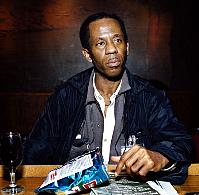 While Zoe Strauss is still my favorite photographer in Philadelphia, as much for her attytood as for her work (see previous post), there’s lots of good fish in the sea. So it was certainly worth my while, and it would be worth yours as well, to check out the show of six photographers at Gallery 339, Philadelphia’s most ambitious and beautiful new space for seeing photographs.
While Zoe Strauss is still my favorite photographer in Philadelphia, as much for her attytood as for her work (see previous post), there’s lots of good fish in the sea. So it was certainly worth my while, and it would be worth yours as well, to check out the show of six photographers at Gallery 339, Philadelphia’s most ambitious and beautiful new space for seeing photographs.
The intelligence of the show–its breadth of work and how that breadth compared and contrasted with the early color photography in “Mavericks of Color” at the Philadelphia Museum of Art (see post)–kept my mind clicking.
Sarah Stolfa’s portraits in McGlinchey’s Bar, from the bartender’s vantage point, continue to astound me with their attention to skin and character. An older photograph from this series is also included in the show, and it offers a little lesson in how sharp her more developed technique is in capturing flesh. The older image has a corporate fuzziness and cooler lighting, which is appropriate for a guy dressed in a suit and tie, but obscures the personal detail that the later photographs achieve. Gallery owner Martin McNamara said Stolfa had figured out a better way to capture the light in the dimness of the bar. He mentioned a slower shutter speed but was otherwise a little fuzzy himself on how she did it (top image, “Arpson Bravos,” archival pigment print, 23 x 23 inches).
Stolfa, who just graduated from Drexel University’s photography program, won a number of awards, including the 2004 New York Times Photography Contest for College Students with this bar series. She has also phogoraphed a series on local boxers.
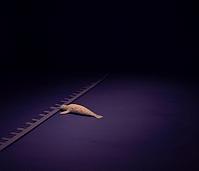
Another young photographer, Yuji Iwasaki, veers away from the documentary impulse that motivates so many photographers. His color-saturated photos of his own clay sculptures, which look real but dislocated, have a pared-down voluptuousness at the same time as they suggest cartoons and narratives. A hunk of cheese on the stairs moves from one frame to the next in the two-image “AM/PM.” A beached seal thumps on a keyboard in “In Tune”. Iwasaki, who is Japanese, went to art school in London. The colors alone are riveting (image, “In Tune,” C-type print mounted on aluminum, 16.5 x 13.75 inches).

The only black-and-white photographer in the show is Daniel Lobdell, whose triptychs here of bridges and nature remind me of the work local photographer James B. Abbott (see post). The black-and-white suggests the past and a return to the time before color photography was even an option. And the images are of breathtaking beauty, in which the signs of man have not yet spoiled the terrain, but only offer a contrast. What I loved best about these photographs was the way the panoramic triptychs are barely discontinuous, so they jolt with a promise of unity that gets subtly broken. Lobdell has a masters from Tyler (image, “Spanning Structures 04-4-2004/2005”, quad-tone print, 30 x 8 inches).
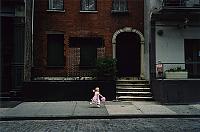
Photojournalist Serge J-F. Levy’s work crosses over into the art world from the commercial world of magazines and newspapers, including The New York Times and London Sunday Times magazines and Sports Illustrated. Juxtaposition and narrative and an eye for flashes of intense color and shafts of light in the gray urban landscape are what make this street photographer’s work catch the eye. The contrast of soccer players in their colorful sportswear playing in a field next to old gravestones, two lit-up figures next to one in shadow, the solitude of a lady in red in a neutral, empty street with a tiny, receding motorcyclist reflected in a car mirror–there’s room for storymaking in each of these photos (image, “Soho, NYC,” photographic C-print, 20 x 16 inches).
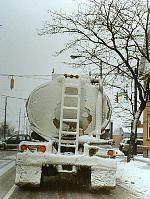
Robert Raczka, who photographs the world around us, seems to be going in a number of directions at once–surprises of scale, surprises of content, shifts in expectation from how we think the world looks to the way the world really looks. Raczka photographs people as well as places. This gasoline tanker coated with snow looks strange and unfamiliar (image, “Gasoline Truck, Meadville, PA,” C-type print, 14 x 18 inches).
Raczka is a professor of art and gallery director at Allegheny College.
Levy’s and Raczka’s work seemed a little more expected (although still engaging) than that of others in the exhibit. Raczka reminded me of Joel Meyerowitz some of the time. And Levy’s work is from the Weegee genre. But I liked the work anyway.
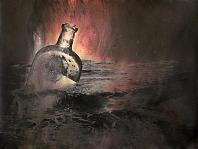
Jackie Fugere, a UArts grad now in New York City, creates work with the spin of Victorian weird science. Plus she uses retro illustrational drawings in some of her images. Using metals in a chancy process to create an image about chance and magic, or creating unpredictable photograms also about chance” seems tautological, plus the images have a cobwebby look–“Message” was the most beautiful of the images. Fugere has also won several awards for her work and has just finished a two-year gig with Center for Emerging Visual Artists (CFEVA) here (image, “Message,” toned silver print–chromoskedasic process, 40 x 30 inches).
Levy is also a CFEVA participant.









